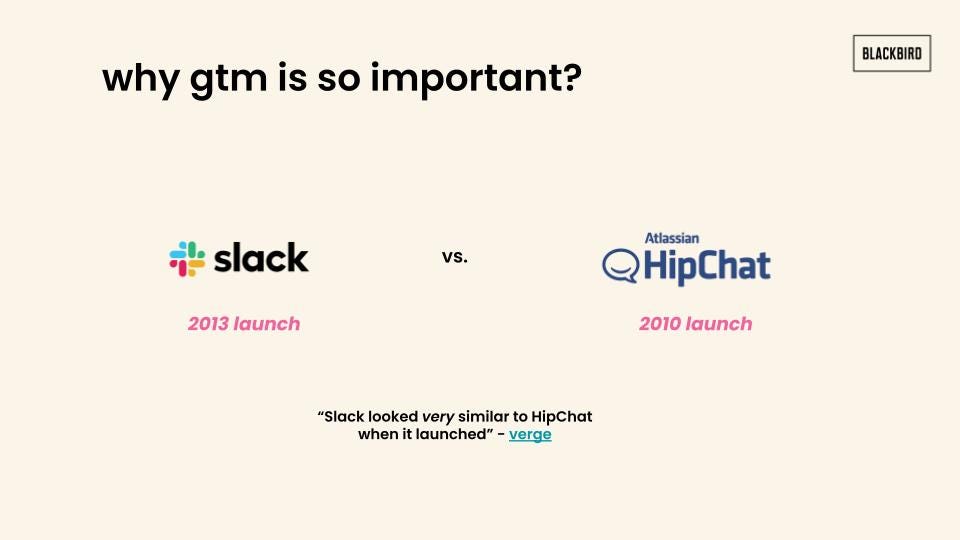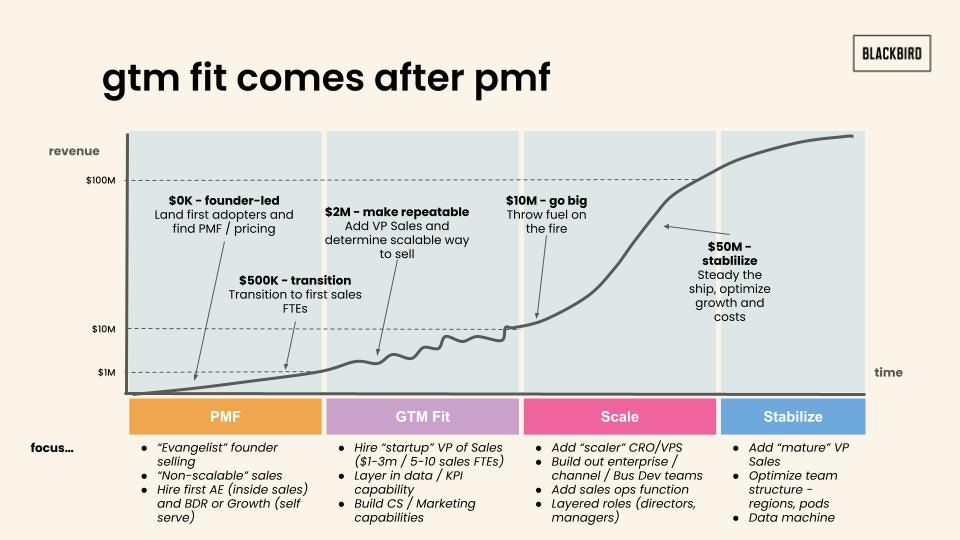Part 1: WTF is GTMF + PLG? Yes, Go-To-Market Fit is a Thing
A Four Part Guide to finding Go-To-Market Fit and achieving Product-Led Growth
Startup literature obsesses over product-market fit, but if you look at the greatest success stories in recent history, they all have an additional thing in common: a dialed-in go-to-market strategy.
From Atlassian to Slack to Afterpay, go-to-market is how you win - even when you’re not the first to market (more on this later). Finding product-market fit may come first sequentially in the journey, but finding “go-to-market fit” comes right after and is just as important.
Welcome to Part 1 of a four part series that dives deep into go-to-market (GTM) and product-led growth (PLG), adapted from a recent Blackbird Founder Academy workshop.
Part 1 provides an introduction to the foundational principles of GTM - what it is, why it is important, and how it has developed over time.
Part 2 covers the key GTM models and the factors relevant to determining your own GTM strategy.
Part 3 digs into “product-led growth”, a top contender for 2021’s hottest buzzwords, and presents a practical framework for founders to explore product-based initiatives (“the PLG Framework”).
Part 4 walks through a real case study for the application of the PLG Framework, drawing on personal experience.
Part 1: Yes, Go-To-Market Fit is a Thing
What is “go-to-market”?
A great place to start a discussion on go-to-market (GTM) is to define what it is. GTM comprises all of the actions that a company takes in interacting with its customers, from reaching (marketing), closing (sales), and retaining and growing them (success).
A company’s GTM should be designed customer-back. The first step is to determine the most natural journey of experience that your customers should have with your product - this is your go-to-market funnel. The next part is to define the ideal actions that you should be taking to support and encourage customers through that journey at scale - your go-to-market strategy.
Sure, fleshing out the detail of the funnel stages is a different exercise for every company - the exact ideal journey for customers of Canva looks very different to Zoox. However, the overarching goals are inevitably always the same: reach, close, retain, grow.
Why is go-to-market important?
There is so much obsession with product-market fit in startup chit chatter that GTM typically doesn’t get much airtime. Yet, it is ultimately an equally critical component to success. The battle of Slack versus Atlassian’s Hipchat helps to emphasize the point.
For all intents and purposes, Hipchat should have won this market tussle and become the dominant workforce collaboration tool. First, it had a 3+ year head start - Hipchat was launched in beta in 2009 and was already dominating the space by the time Slack launched officially in 2013. Second, in early 2012, it was acquired by Atlassian, gaining the benefits of its resources and the unique opportunities for cross-sell into Jira and Confluence customers. And third, Slack and Hipchat were largely at feature-parity - according to Verge, “Slack looked very similar to HipChat when it launched”.
But Slack won - why? This was the same market and effectively the same product, so both had product-market fit. Ultimately, it came down to GTM. Atlassian had maintained the same GTM playbook for Hipchat that had worked so well for its Jira product - a “free trial then convert to paid” orientated motion. Slack, on the other hand, had opted for it’s now well known (but at the time fairly innovative) freemium model with metered pricing. The latter turned out to be the winning strategy.
Go-to-market fit comes after product-market fit
This is not to diminish the importance of product-market fit, and that ultimately comes first in the startup lifecycle. Product-market fit (PMF) is about making sure you have built a product that meets a relevant market demand. Once you have that, GTM fit kicks in and is about figuring out how to get that product into the hands of the market opportunity rapidly and efficiently.
This is an important point to make. Founders may think they need to have their GTM nailed in the early days pre-Series A while they are still figuring out their product and optimal place in market - effectively seeking to “build the ship as we sail it”.
No, in that period you should be myopically focused on securing first adopters and finding product-market fit, and this will typically involve doing things that are antithetical to GTM logic - founder-led “evangelist” selling, customer experimentation and product iteration, and non-scalable market activities. Hiring up in sales and marketing too early can be dangerous and you should wait for the convincing signals of customer love and market pull before investing too heavily in those areas.
The dynamic evolution of go-to-market
Go-to-market strategies have developed over time in sync with major technology innovations, and will continue to do so. Some of the most seismic shifts in GTM have been the innovation of subscription SaaS in the 2000s (enabled by the cloud), bottom-up sales in the 2010s (enabled by mobile, social media and the new “prosumer”), and embedded fintech in the 2020s (enabled by banking- and payments-as-a-service).
These shifts have also coincided with key changes in buyer behaviours (from less educated to more educated), methods of selling (from product selling to consultative selling), and models of selling (from field sales to inside sales to self-serve to social selling).
In summary, finding go-to-market fit is just as critical as finding product-market fit and GTM approaches adapt over time with technological innovation. In Part 2, we will dig into the different GTM models and how a founder might go about determining their optimal strategy - read it here
This content first appeared on Blackbird Ventures blog and has been developed from our Blackbird Founder Academy, a cohorted program where we help our portfolio leaders to level up, together.







